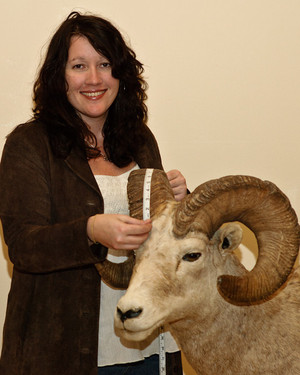Professor studies struggling North American bighorn populations

Despite much advancement in wildlife conservation during this generation, a Chadron State College professor tells about a North America species that continues to face great adversity – the bighorn sheep.
“They have transitioned from a species of relative abundance to one of the most rare ungulates in North America,” said Dr. Teresa Zimmerman, the faculty member who leads CSC’s wildlife management program. “They are a species of concern because of what we have done to their habitat, our infiltration into montane systems, and also the effects of our livestock.”
Despite conservation efforts, she noted that bighorn populations continue to struggle throughout the West, including those at Fort Robinson State Park near Crawford. Like other populations, the Fort Robinson bighorns have been diseased by contact with domestic sheep, she said.
Zimmerman, who studied bighorn sheep at Badlands National Park for her doctoral dissertation, noted that bighorns and humans have coexisted for about 30,000 years, but major declines have occurred in just the past 150 years. During that period, the bighorn population in North America has deteriorated from an estimated high of 4 million to a low of 22,000, she said.
She cites research linking pneumonia in herds of bighorns to domestic sheep, which have evolved from the same ancestors but in climates not as dry and cool. Because of the environment, the various species of bighorns developed in areas largely free of the parasites and bacteria that cause illness. She likens the impact of the introduction of domestic sheep on bighorn populations to that of the effect of European people on American Indian populations, who suffered from smallpox and other diseases foreign to their immune systems.
Zimmerman said it’s a certainty that a bighorn that contacts domestic sheep will contract pneumonia. “Contact” happens easily, she said, as the bacteria from domestic sheep that causes pneumonia in bighorns can be spread by airborne mechanisms. It is recommended that about 10 miles separate domestic sheep and bighorn populations. Typically, a herd loses 90 percent of its population after coming into contact with domestic sheep, and low birth rates ensue.
While advancements have been made in treating ailing bighorns with antibiotics, she said the method is extremely expensive and generally not effective.
Zimmerman spoke about the bighorns Tuesday, Oct. 26, as part of the Graves Lecture Series at the King Library. Much of the presentation focused on the bighorns’ history, behavior and characteristics. She outlined the bighorns’ migration to North America over the Bering Strait 20 million years ago, and how more than a half dozen subspecies developed from isolation caused by North American glacial activity.
She told about the human activities that forced extinction of the Audubon’s bighorn sheep, which once thrived in the Great Plains including northwest Nebraska. The last known sheep of that subspecies was killed by a South Dakota hunter in 1923. Reintroduction efforts in the Great Plains have consisted of Rocky Mountain bighorns, including populations at Fort Robinson, the Pine Ridge,and the Wildcat Hills near Scottsbluff.
She encourages people concerned about the bighorns to support agencies that promote wildlife conservation and policies to regulate domestic sheep and goats. She also said they should support land acquisitions that will keep bighorn herds separated from humans and livestock.
“It is important to conserve the species that are here,” Zimmerman said. “I think of it like a puzzle. If a piece to a puzzle is lost, we often don’t realize the entire system may be ruined. There are many species that play a role in our ecosystem, and it’s important to make sure each is not destroyed from our actions.”
Category: Campus News, Employee Awards & Achievements, Range Management

